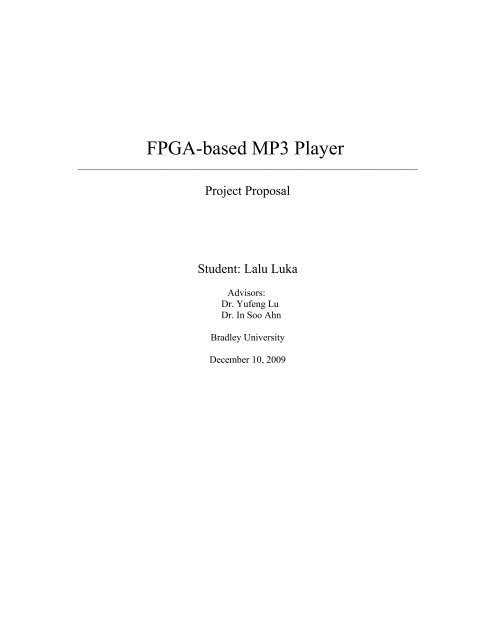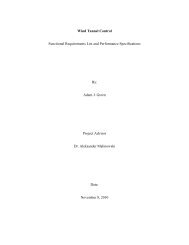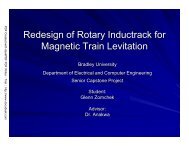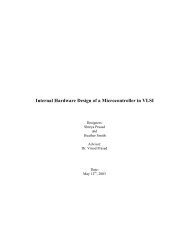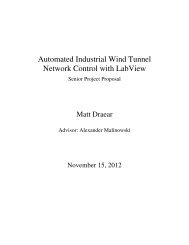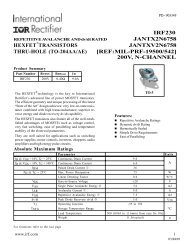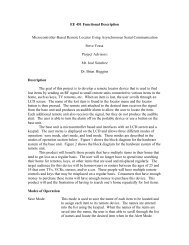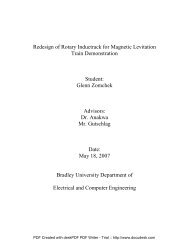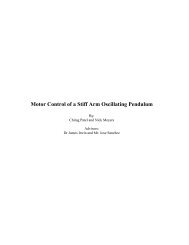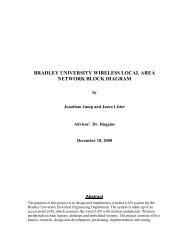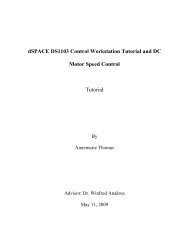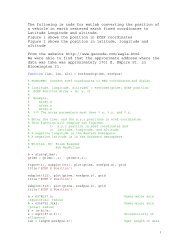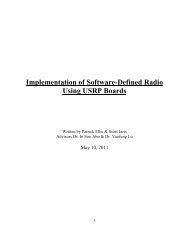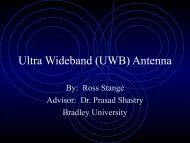You also want an ePaper? Increase the reach of your titles
YUMPU automatically turns print PDFs into web optimized ePapers that Google loves.
<strong>FPGA</strong>-<strong>based</strong> <strong>MP3</strong> <strong>Player</strong><br />
______________________________________________________________________<br />
Project Proposal<br />
Student: Lalu Luka<br />
Advisors:<br />
Dr. Yufeng Lu<br />
Dr. In Soo Ahn<br />
Bradley University<br />
December 10, 2009
Introduction<br />
Digital design using a Field Programmable Gate Array (<strong>FPGA</strong>) is a rapidly evolving<br />
field. A complete embedded system can be built and programmed into a single <strong>FPGA</strong><br />
chip for digital signal processing applications.<br />
The goal of this project is to design a MPEG Layer III (<strong>MP3</strong>) player using a <strong>FPGA</strong> board.<br />
The <strong>FPGA</strong> will read <strong>MP3</strong> source files, decode them into a 16-bit Pulse Code Modulated<br />
(PCM) output, and play the audio files through an external speaker.<br />
Project Goals<br />
• Gain an in-depth understanding of hardware/software co-design using <strong>FPGA</strong>s.<br />
• Understand the specifications set by the ISO/IEC 11172-3 standard for encoding<br />
and decoding <strong>MP3</strong> files.<br />
• Build a <strong>FPGA</strong>-<strong>based</strong> <strong>MP3</strong> system, which implements the <strong>MP3</strong> decoding<br />
algorithm using VHDL and C language on the Embedded Development Kit<br />
(EDK) software platform.<br />
• Design a user friendly interface that<br />
o Enables the user to scan through the <strong>MP3</strong> file list, and then select, play,<br />
pause, and/or stop the song.<br />
o Displays related information on the LCD such as song title and author(s).<br />
o Advanced features, such as volume control, rewind and forward modes<br />
will be added to the system, if time permits.<br />
USER INTERFACE<br />
LCD<br />
Title , Author<br />
ON/OFF<br />
Select MP 3 File<br />
Play<br />
Pause<br />
Stop<br />
Volume Control<br />
(Forward )<br />
(Rewind )<br />
Using pushbuttons and<br />
switches on <strong>FPGA</strong><br />
Development System<br />
Board<br />
Compact Flash<br />
Memory with<br />
Preloaded MP 3 Files<br />
Xilinx Virtex -5<br />
XC5V LX 110T<br />
<strong>FPGA</strong><br />
Decoder<br />
PCM<br />
Control Signal<br />
Stereo AC 97<br />
Audio Codec<br />
(On Board )<br />
Figure 1 High Level System Block Diagram<br />
Speaker
The system includes:<br />
User Interface<br />
The user interface provides the inputs to control the <strong>MP3</strong> player, such as<br />
scanning, selecting, playing, pausing, and stopping the <strong>MP3</strong> files. It will also<br />
allow to output related information (i.e, title and author of the song) on the LCD.<br />
Compact Flash Memory Card<br />
The compact flash memory (CFM) card supplies the preloaded <strong>MP3</strong> files for the<br />
<strong>MP3</strong> decoder system in the <strong>FPGA</strong>. <strong>MP3</strong> files are loaded onto to the CFM using a<br />
PC and memory card reader.<br />
Onboard Stereo Audio AC97 Codec<br />
The AC97 codec (i.e., AD1981B) is used to convert the PCM format signal from<br />
the <strong>MP3</strong> decoder into an audio signal, which is fed into an external speaker<br />
through an audio jack.<br />
<strong>MP3</strong> Decoder<br />
A <strong>MP3</strong> decoder runs on the Xilinx Virtex-5 XC5V LX110T <strong>FPGA</strong> that will<br />
decode the selected <strong>MP3</strong> stream with the sampling frequency specified in the<br />
<strong>MP3</strong> header. A typical sampling frequency is 44.1 kHz.<br />
Decoding Process Overview:<br />
The decoding process is shown in Figure 2. It includes the following stages: initial<br />
reading, Huffman decoding, re-quantization and reordering, stereo decoding, alias<br />
reduction, inverse modified discrete cosine transform (IMDCT), and synthesis polyphase<br />
filter bank [1-7].<br />
Figure 2 High Level Diagram of Decoding Process
1. Initial reading<br />
The incoming data stream is split up into individual frames. The header<br />
section of each frame is analyzed to obtain parameters used in the encoding<br />
process (i.e. bit rate and sampling frequency).<br />
2. Huffman decoding.<br />
The Huffman algorithm is used for lossless data compression.<br />
The basic idea of the technique is to assign shorter binary codes to more<br />
frequent samples and longer codes to less frequent samples.<br />
The decoding is <strong>based</strong> on tables that are used to map the Huffman binary<br />
codes to the original samples.<br />
3. Re-quantization and re-ordering<br />
The Huffman decoder output is scaled up for different frequency spectrum<br />
ranges and sorted by increasing frequency ranges.<br />
4. Stereo decoder<br />
The output from re-ordering block split into two identical outputs for the right<br />
and left channels.<br />
5. Alias reduction block<br />
In the <strong>MP3</strong> encoding process, anti-aliasing filters have been added to the<br />
signal. To obtain a correct reconstruction of the signal in the <strong>MP3</strong> decoding<br />
process, special designed butterfly calculations are applied to each frequency<br />
spectrum range to reconstruct the aliasing artifacts.<br />
6. Inverse Modified Discrete Cosine Transform (IMDCT)<br />
A counterpart of the MDCT in the encoding stage of <strong>MP3</strong> file.<br />
DCT is an energy-compaction transformation for real-number signals.<br />
7. Synthesis polyphase filter bank<br />
Compared with analysis polyphase filter bank, synthesis polyphase filter bank<br />
is used to combine the signals from different frequency spectrum ranges.<br />
The output of the synthesis polyphase filter bank is in PCM format.
System functional requirements and performance specifications:<br />
Input <strong>MP3</strong> bitstream requirements<br />
The <strong>MP3</strong> player will decode <strong>MP3</strong> inputs with various bit rates (from 128 kbps to<br />
320 kbps) and different sampling frequencies (32 kHz, 44.1 kHz or 48 kHz)<br />
Decoding speed<br />
The ultimate objective of decoding speed is to process <strong>MP3</strong> files in real-time. The<br />
execution time of the <strong>MP3</strong> decoding will be profiled and measured. If the realtime<br />
specification can not be met, further optimization will be needed.<br />
LCD display<br />
The LCD will list the <strong>MP3</strong> information in real-time.<br />
Preliminary progress:<br />
The first few weeks have been dedicated to becoming familiar with the Embedded<br />
Development Kit Platform Studio software. Xilinx tutorials and board demonstration<br />
projects have been studied. In addition, peripheral setup, compilation, and debugging<br />
procedures have been practiced extensively.<br />
C programs have been written to read from a compact flash memory (CFM). First, the<br />
CFM is preloaded with .txt or .dat files. Then, the C program running on the <strong>FPGA</strong><br />
fetches the file (.txt or .dat) and outputs the contents on a hyperterminal. It proves that<br />
CFM is accessible using C programming. In the actual implementation of the project,<br />
<strong>MP3</strong> files will be preloaded instead.<br />
Patent search:<br />
Reference codes for existing <strong>MP3</strong> decoders were obtained. All software provided<br />
requires no license and users are free to implement or modify them (see [8] and [9]).<br />
Equipment list:<br />
Table 1. Equipment list<br />
Item Description<br />
Xilinx UPV5-LX110T <strong>FPGA</strong> <strong>FPGA</strong> used to implement decoding process<br />
AD1981B JSTZ Onboard AC97 Stereo Codec Chip used to convert<br />
decoder digital PCM outputs to analog audio sound<br />
1 GB Compact Flash Memory (CFM)<br />
and an external memory card reader<br />
waves.<br />
The CFM holds preloaded Mp3 files to be accessed<br />
and decoded by <strong>FPGA</strong> system. Eventually decoding<br />
process software will be run from the CFM, so that an<br />
external PC is not required.<br />
Headphones or external speaker Headphones will be connected through the AC97<br />
audio jack (driven by the audio codec's internal<br />
50-mW amplifier).
Preliminary schedule:<br />
The schedule for the Spring 2010 semester is given in Table 2, below. A significant<br />
amount of time will be used to integrate the <strong>MP3</strong> system.<br />
Table 2. Spring 2010 schedule<br />
Week # Dates Activity<br />
1-2 01/24-02/06 Stereo AC97 interface.<br />
3-4 02/07-02/20 LCD and user interface setup.<br />
5-8 02/21-03/20 <strong>MP3</strong> decoding system (Huffman decoding, alias reduction,<br />
IMDCT, synthesis filter) testing and debugging<br />
9-10 03/21-04/03 System performance evaluation, optimization<br />
11-14 04/04-05/01 System optimization, debugging, and documentation.<br />
References<br />
[1] A. Abdel-Gawad, “A full hardware implementation for an <strong>MP3</strong> decoder chip<br />
using VHDL”, Project Report, University of California at Santa Barbara, December 2008.<br />
[2] M. Botteck, H. Blume, J. von Livonius, M. Neuenhahn, and T. Noll, “Programmable<br />
architectures for realtime music decompression”, Proceedings of Parallel Computing:<br />
Architectures, Algorithms, and Applications Conference, vol. 38, pp. 777-784, September<br />
2007.<br />
[3] K. Brandenburg, and H. Popp, “An introduction to MPEG layer-3”, European<br />
Broadcasting Union Technical Review, pp. 1-15, June 2000.<br />
[4] P. Chandraiah, and R. D¨omer , “Specification and design of a <strong>MP3</strong> audio decoder”,<br />
Technical Report CECS-05-04 , University of California at Irvine, pp. 1-83, May 2005.<br />
[5] International Standard ISO/IEC 11172-3. “Information technology - Coding of moving<br />
pictures and associated audio for digital storage media at up to about I,5 Mbit/s –<br />
Part3: Audio,” January 1999.<br />
[6] W. Jiang, S. Polisetty, and X. Li, “Huffman decoder”, Project Report, University of<br />
Tennessee at Knoxville, May 2003.<br />
[7] G. Liaskos, “<strong>MP3</strong> File Structure”, Internet Resource :<br />
http://www.multiweb.cz/twoinches/<strong>MP3</strong>inside.htm#<strong>MP3</strong>FileStructure<br />
[8] R. Leslie, “MAD: MPEG Audio Decoder” Internet Resource:<br />
http://www.mars.org/home/rob/proj/mpeg/<br />
[9] M. Hipp and O. Fromme. “MPG123” Internet Resource:<br />
http://www-ti.informatik.uni-tuebingen.de/~hippm/mpg123.html


